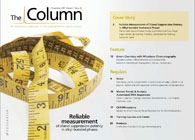Environmental contamination with steroids
A team of researchers led by Nawed Deshmukh of the School of Pharmacy and Chemistry at Kingston University (London, UK) has published new research using liquid chromatography?tandem mass spectrometry (LC?MS?MS) to identify steroid contamination in environmental water samples in Budapest, Hungary.
A team of researchers led by Nawed Deshmukh of the School of Pharmacy and Chemistry at Kingston University (London, UK) has published new research using liquid chromatography–tandem mass spectrometry (LC–MS–MS) to identify steroid contamination in environmental water samples in Budapest, Hungary.
The synthetic anabolic steroid stanozolol is often misused as a performance-enhancing drug and as an illegal growth aid in veterinary practice. These researchers previously reported stanozolol in hair samples collected from subjects living in Budapest. That finding prompted the current study of environmental contamination with the steroid.
In the study, the team used liquid–liquid extraction using pentane, which they found to be an efficient method for the extraction of stanozolol from water samples. This step was followed by direct detection using LC–MS–MS. The method was capable of detecting a 0.25 pg/mL concentration of stanozolol when only 5 mL of water was processed in the presence of stanozolol-d3 as internal standard. The method developed was found to be efficient, rapid, reproducible, sensitive and robust for the detection of stanozolol in aqueous matrices.
Three out of six samples from the Danube river, collected from December 2009 to November 2010, were found to contain stanozolol at concentrations up to 1.82 pg/mL. In contrast, only one sample (out of six) of urban tap water from the city of Budapest was found to contain stanozolol, at a concentration of 1.19 pg/mL. A total of 15 bottled waters analysed were found to be negative for the steroid.
The study was published in Chemistry Central Journal on 14 October 2011.
This story originally appeared in The Column. Click here to view that issue.

Analysis of PFAS in Milk by LC-MS/MS
May 15th 2025Dairy milk is one commodity that can be impacted by environmental contaminants, such as PFAS, so it is important to implement extensive, robust, and accurate testing. In this work, a sensitive and reliable method was developed for the analysis of PFAS in milk by LC-MS/MS at levels as low as 0.01 µg/kg.

.png&w=3840&q=75)

.png&w=3840&q=75)



.png&w=3840&q=75)



.png&w=3840&q=75)










